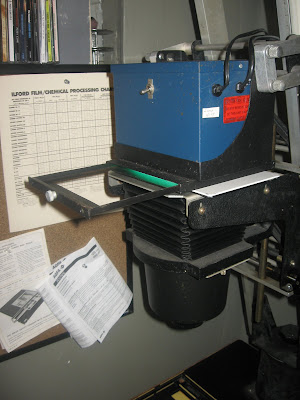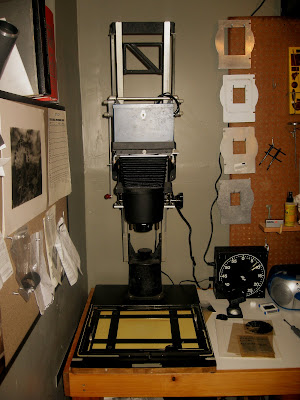


"New" cold light head for my enlarger. Two years ago I became interested in trying out cold light enlarger heads as an alternative to the condenser light source I had always used. The standard condenser head with its hot incandescent light projected through two condensers focuses the light in straight lines giving a very sharp and contrasty print. The condenser heads brought out all of the detail in the negative along with all the flaws such as scratches, dust, chips in the emulsion. etc. The cold lights used florescent bulbs that were cooler and the light was projected through a diffusion filter that scattered the light . The cool light kept the negatives from warping and the diffusion 'softened' the image as well as the imperfections in the negative,reduced contrast and stretched the mid tonal range. Ansel Adams was a proponent of the cold light over the condenser head. One of the problems with the older fluorescent was that unlike an incandescent light which flicks on close to maximum output the florescent take awhile to warm up. Printing requires an exposure of 60 seconds or less and the fluorescent could vary in the intensity depending on how long the light had been on. One solution was to keep the light on constantly while printing and use a lens cap to shut off the light when the proper exposure had been made. Omega made a diffusion enlarger head called the 'Omegalite' with a circular doughnut shaped florescent light back in the 1940's. My first cold light I used was one of this type. It was dimmer then a condenser light source, and focusing was more difficult but with a good negative it did provide an alternative to the sharp condenser light source softening the image just a bit to eliminate some imperfections in the negative. The florescent also lasted much longer and I didn't have to swap condensers every time I worked with a different film size just change the enlarger lens. I upgraded to an Aristo grid light a year ago that was a special florescent designed for cold light heads and was brighter and the design provided more even illumination. The light units also had a heater which kept the bulb warm which I believe kept the light output even when it was turned on. The problem though was that the cold lights were made to use with graded papers rather then variable contrast paper. Graded papers are difficult to find and there are some advantages to variable contrast papers that allow for stretching the tonal range further with split filtering techniques. You can use variable contrast paper without filters and will pretty much get a grade 3. The older cold lights used a white light that was more towards the blue end of the spectrum, and the filters were designed for use with incandescent lights that were more towards the red. It was suggested that you use a special yellow gel filter with the older cold lights to bring the light closer to a range that worked with variable contrast filters and the paper they were designed for. I recently found an older Aristo head built to use with a D-2 that had a filter drawer but it needed a bulb. I did some research and cold lights were being made that worked better with filters. The lights are called a V-54.http://www.aristogrid.com/v54art.htm I received a lot of help from the Aristo Light company in finding the right bulb that would work with my particular head . I just got the bulb today and set it up and did some printing this evening. I used the same negative I printed this weekend using variable contrast paper without a filter. I made prints with a 1, 1 1/2, and 2 numbered filters and after the prints dry down I can compare them to the prints I made this weekend to see if there is much improvement. I'll still use my condenser system but now if I want to experiment with a cold light I won't have to sacrifice the variability of multiple contrast filters.


0 Comments:
Post a Comment
<< Home